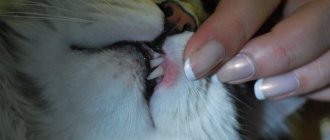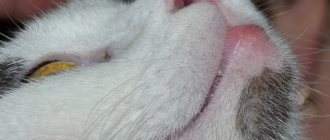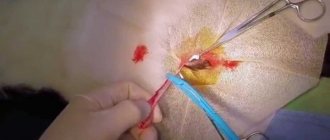Causes and symptoms of lymphadenitis in cats
Factors that provoke changes in the size of lymph nodes and the development of inflammation in them can be very diverse.
Serious diseases that affect organs located next to the lymph nodes or the lymphatic system itself can provoke lymphadenitis in cats. The causes of the development of lymphadenitis are acute respiratory viral infections, infectious lesions of fungal or bacterial origin, immunodeficiency virus in cats, parasitic lesions of organs (mainly the digestive system).
Often, a decrease in the immune response is observed in autoimmune pathologies, any diseases in the acute stage, lymphomas and malignant neoplasms that metastasize to the lymphatic system, from where they penetrate the systemic bloodstream and spread throughout the body.
The diagnosis of lymphadenitis can only be made by a veterinarian after a thorough examination and laboratory tests. In some cases, additional diagnostic measures are carried out to determine the factor that provoked inflammation in regional and other large lymph nodes.
The danger of the pathology lies in the fact that a pathogen located in the lymphatic system and untimely neutralized can penetrate into any part of the body. In addition, if one node is inflamed, a pathological process occurs in nearby tissues. In this regard, it becomes difficult to identify the underlying factor that caused lymphadenitis.
Lymphadenitis develops in cats and kittens that have problems with their immune status and are often subject to allergic reactions. Inflammatory processes can develop in the body of a cat with a number of chronic diseases, as well as in animals with problems in the endocrine system.
There are several types of lymphadenitis. They are divided according to the location of the lymph nodes. There are superficial and deep lymphadenitis, as well as chin, submandibular, inguinal, axillary and behind-the-ear. The path of pathogen entry into the body and its spread through tissues may be different. Acute respiratory infections and sepsis can provoke lymphadenitis.
The nature of the pathology can also be acute or chronic, while chronic is divided into purulent and hyperplastic.
The purulent type of the disease is characterized by an increase in body temperature, a sharp change in the skin around the inflamed lymph nodes. Lethargy and apathy are noted in the pet.
In normal condition, lymph nodes located on the surface cannot be palpated. Sometimes they can be felt in the form of specific balls under the skin. Factors that provoke the development of lymphadenitis determine the development of symptoms. Characteristic signs of lymphadenitis are:
- changes in the size of lymph nodes;
- hyperemia of the skin at the site of injury;
- pain in the pet when the owner touches the lymph node;
- fusion of inflamed tissues with lymph nodes into a large lesion;
- increased body temperature;
- signs of intoxication;
- severe weakness;
- refusal of food.
With lymphadenitis caused by a secondary infection, only partial signs of inflammation occur. If lymphadenitis is of a chronic type, symptoms develop in full. At the initial stages of the development of lymphadenitis, treatment is most effective; in later cases of diagnosing inflammation of the lymph nodes, therapy is long and complex.
The chronic form of tuberculosis is provoked by the tuberculosis bacillus or other pathogens. Fungal and bacterial microorganisms cause an acute form of lymphadenitis, which can subsequently cause complications, such as the formation of thrombosis. In the case where inflammation in the area of the lymph nodes is caused by a decrease in resistance, there is no particular problem in treatment. With lymphadenitis arising against the background of malignant neoplasms, the clinical picture changes. The following signs are observed in a cat:
- a sharp increase in the size of regional lymph nodes;
- damage to the lymph nodes by a tumor provokes the appearance of tuberosity on the surface of the lymph node.
The animal does not experience any particular painful sensations in the initial stages of tumor development, so timely consultation with a doctor is usually delayed. Enlarged lymph nodes located in the groin or armpits cause lameness in the cat. The cat owner should promptly notice the changes and seek help from a veterinary clinic.
Diagnosis of lymphadenitis in cats.
| Body parts | Location and features of neoplasms |
| Maxillary department | The lesions often occur under the rounded part of the jaw |
| Elbow joint | Their structure resembles “cones” (bulges) |
| Appear on the forelimbs | |
| Knee cap | Located on the hind legs under the knee |
| Armpits | The nodes extend towards the head, they are easy to find by touch under the armpits of the front paws |
| Inguinal region | Formed in the groin, near the inside of the hip joint |
A doctor will help you make an accurate diagnosis by first drawing blood and urine for testing.
You can diagnose inflammation of the lymph nodes yourself by carefully palpating all areas of your pet’s body. If this is not enough, you need to seek help from a specialist and have your cat tested: blood, urine, biopsy. Only after such procedures can an accurate diagnosis be made and effective treatment or surgical removal of tumors prescribed.
In case of infectious pathology, it is allowed to treat it at home, but in order to avoid complications, it is necessary to consult a veterinarian. You need to pay close attention to the cat’s diet, mood, general health and the process of emptying its intestines; if everything is normal, then there is no need to worry.
After undergoing tests and making a diagnosis, the doctor prescribes complex medication therapy. It consists of antifungal medications and antibiotics, and a vitamin complex is also included. In some situations, the doctor sends the animal for a biopsy. If the diagnosis of oncology is confirmed, then treatment depends on the severity of the disease and the time when the tumor began to develop.
Cats, like all other mammals, have numerous external (peripheral) lymph nodes (or glands) that can be palpated during a physical examination.
This is very important, since inflammation of the lymph nodes and changes in their size can be easily detected without complex diagnostic tests. Reptiles and birds, for example, do not have external lymph nodes.
During the examination, five external lymph nodes are usually palpated. They are all paired, which allows them to be compared with each other, noticing subtle changes in size.
Located directly opposite the shoulders. To find them, you should place your hands on the cat's shoulders.
Located on each side of the chest, in the armpit areas. They tend to be small and more forward than most people expect.
Located on the stomach, on the inside of the hind legs. There is usually a significant amount of fat present, so they can be difficult to feel even if they are enlarged. In addition, there are breast tissues that can be mistaken for enlarged lymph nodes if they are inflamed or swollen.
Located on the cat's hind legs on the side opposite the knee. They are quite close to the surface and are easy to feel.
The presence of inflamed lymph nodes in a cat is a sufficient cause for concern for the owner
However, first of all, conduct your own “investigation”; it is important to know the location of natural sieves:
- submandibular - the formation is located under the rounded part of the jaw;
- elbow - the structural features of the shoulders of the front paws make it possible to palpate the lymph nodes;
- popliteal - can be felt on the hind leg, the opposite side from the knee;
- axillary - the lymph nodes are extended towards the head and can be easily felt in the axillary region of the front legs;
- inguinal - location is dictated by the physiological characteristics of the structure. The owner can feel the formations in the area of the inner thigh (moving from the lower mammary glands to the tail).
It is important to know that if in a short time all the lymph nodes on the body are swollen in a representative of the cat family, then these are serious symptoms of diseases such as leukosarcoma or leukemia. Under any circumstances, owners should not limit the diagnosis to a home examination, but take the cat to a veterinary hospital, where he will have a blood test, palpation of the affected areas of the body, and also examined using ultrasound, x-rays and biopsy
Cats, like all mammals, have numerous external (peripheral) lymph nodes (or glands) that can be palpated during a physical examination.
This is very important, since inflammation of the lymph nodes and changes in their size can be easily detected without complex diagnostic tests. Reptiles and birds, for example, do not have external lymph nodes.
What to do if your animal has inflammation of the lymph nodes
First of all, the owner should not panic. If the disease is viral or infectious in nature, then treatment at home is allowed.
The owner should pay special attention to:
- General condition of the animal.
- His appetite.
- How does a pet go to the toilet?
Veterinarians recommend not taking any action for a while and allowing the body to overcome the disease on its own. If the disease does not go away and the lymph nodes are noticeably enlarged, it is best to seek qualified help. The answer to the question of how and with what to treat inflammation of the lymph nodes largely depends on the causes of the inflammatory process. First of all, the veterinarian must find out the pathology that “contaminates” the blood.
If a cat has a high temperature for a long time and behaves very nervously, you need to undergo a general biochemical blood test and consult a specialist with its results. Most often, treatment is prescribed in case of inflammation of the inguinal lymph nodes, since this disease can spread to all internal organs and systems.
In case of inflammation of the lymph nodes, it is better to conduct blood tests.
If the tests do not help determine the cause of the inflammation of the lymph nodes, the animal is prescribed a comprehensive treatment that involves the use of antiviral, anti-inflammatory and antifungal medications.
First aid at home
Lymphadenitis, regardless of the form and nature of the course, cannot be ignored due to the development of possible complications.
First aid at home is aimed at improving and normalizing the general condition of the pet. It is impossible to recommend specific treatment methods, since lymphadenitis is most often a consequence of various pathologies and diseases.
The choice of drugs for general and local therapy depends on the cause. Cold compresses and anti-inflammatory medications will help relieve inflammation. To eliminate pain, analgesics are given.
Symptoms of the disease
The diagnosis depends entirely on the reasons why the lymph node is enlarged. In the case of lymphadenitis in a cat, the nodes undergo such characteristic changes as:
- the affected lymph nodes are hot to the touch compared to other parts of the body;
- The disease always affects two nodes parallel to each other, and their increase is not symmetrical;
- with an inflammatory process in the lymph nodes that are located in the neck, the main symptom is a sore throat in the pet;
- the cat’s appetite decreases, against the background of this, thirst increases, the animal is able to absorb huge amounts of water;
- the pet becomes apathetic, prefers to lie in one place, and reacts sluggishly to the owner’s attempts to cheer him up.
For oncological pathologies, the symptoms are somewhat different; they include:
- intense increase in the size of one lymph node;
- the resulting neoplasm is not so smooth as in the case of lymphadenitis, but rather ribbed or lumpy;
- In the initial stages of the disease, the cat’s behavior does not change, and the resulting tumor does not bother him in any way.
If the inflammatory foci are in the axillary or inguinal lymph nodes, then the pet begins to limp. An attentive owner can detect the presence of health problems in a cat by simply palpating its body. If alarming symptoms are detected, the pet should be immediately taken to an appointment with a veterinarian.
Treatment of the disease
If the etiology of the disease is infectious, treatment at home is acceptable, but in order to avoid complications, it is advisable to additionally consult with a specialist. Particular attention should be paid to the general condition of the cat, its appetite and the process of defecation. At first, you don’t have to treat the animal at all, giving the immune system the opportunity to cope with the problem on its own. If the lymph nodes continue to increase rapidly, and the cat’s body temperature is elevated, then you should seek qualified help.
Using a biochemical blood test, the doctor will try to determine the actual cause of the inflammation and then prescribe the correct drug therapy. It is carried out comprehensively, including antibiotic and antifungal drugs, as well as vitamins, to maintain the body’s defense systems.
In some cases, the veterinarian may insist on a biopsy from the lymph node. Unfortunately, medicine has not yet come up with a single and effective treatment for oncology. It all depends on the extent of the damage and how quickly the cancer was detected. The therapeutic regimen includes chemotherapy and surgery, as well as taking hormonal drugs and immune stimulants.
It should be said right away that the risk of a fatal outcome is very high, about 85%. However, no specialist will give a 100% guarantee that after all phases of treatment there will be no relapse. If the neoplasm has metastasized throughout the cat’s body, then euthanasia is recommended so as not to prolong the pet’s suffering.
Finally, I would like to say that lymphadenopathy is a rather dangerous pathological condition that can develop in both a kitten and an adult. It may indicate that the cat has both fairly treatable lymphadenitis and a terrible cancerous tumor. The owner should closely monitor the health of their pet and regularly feel it for enlarged lymph nodes. If such a symptom is detected, you should not waste time and take the cat to see a doctor.
Features of inflammation depending on location
Clinical manifestations depend on where the lesion is located. Let us consider the features of inflammation depending on the localization of pathological processes.
On the front and hind legs
If there is an inflammatory process on the front and hind legs, in addition to weakness, lethargy, and high temperature, lameness, stiff gait, discomfort due to increased tension in the muscle structures, and pain when walking are noted.
The axillary, supraclavicular, ulnar lymph nodes, and inguinal nodes are affected during inflammation of the hind limbs. Causes: infections, injuries.
Damage to the lymph nodes in the neck
The lymph nodes in the neck become inflamed due to viral or bacterial infections, or when eating low-quality, stale meat. Noted for toxoplasmosis, respiratory infections (rhinitis, tracheitis, bronchotracheitis, laryngotracheitis, sinusitis, tonsillitis).
The nodes are painful and greatly enlarged. The animal is lethargic, apathetic, and refuses food. Depression gives way to anxiety. A white coating is noticeable on the tongue. An unpleasant odor emanates from the mouth.
Submandibular lymph nodes, on the cheeks
Submandibular nodes and lymph nodes on the cheeks become inflamed due to viral and bacterial infections, dental diseases (stomatitis, gingivitis), injuries to the oral mucosa, and penetration of pathogenic agents into regional lymph nodes. Located under the angular rounding of the jaw near the salivary glands, in the cheek area (lymph nodes on the cheeks).
Cats have difficulty eating and drinking water. The oral mucosa is hyperemic and edematous. The temperature is increased by 1-2 degrees from normal. Loss of appetite causes your cat to lose weight.
In the groin, on the stomach
Inflammation of the lymph nodes in the groin and abdomen is a fairly commonly diagnosed form of lymphadenitis in cats. The nodes filter lymph coming from organs located in the peritoneum, groin, and genitals.
The inguinal nodes in cats are located on the inside of the hind limbs. Due to the fat layer, they are quite difficult to palpate, even if they are enlarged.
Inguinal lymphadenitis is caused by:
- viral, bacterial infections;
- inflammatory processes in the pelvis;
- oncology;
- diseases of the genitourinary tract;
- poisoning with toxins;
- diseases of the gastrointestinal tract of inflammatory nature;
- wounds, injuries of the peritoneum, genitals.
A sick pet is lethargic, constantly sleeps, takes unnatural positions, looks for secluded cool places, and refuses food. The temperature is unstable, increased by 1-2 degrees from normal. Urination is painful and difficult. In females, swelling and tenderness of the mammary glands are noted. In the area of inflammation, foci of extensive damage to nearby tissues are noted. The formation of purulent foci and abscesses is possible.
In the armpits
The axillary lymph nodes are located under the armpit of the front legs. Lymphadenitis of the axillary nodes can be triggered by allergic reactions, inflammatory processes, furunculosis, viral infections, and colds.
When the lymph nodes in the armpits are inflamed, the animal experiences discomfort, pain, and difficulty walking. The cat is inactive, lethargic, and constantly sleeps. The nodes are painful and enlarged.
In the ears
If the lymph nodes in the ears are inflamed, most often the pathology is caused by inflammatory processes localized in the inner, middle ear. The cause may be viral, respiratory infections, injuries, tumors in the ears, and dental diseases.
In addition to the increase in inflamed nodes, pain, high temperature and swelling in the ear area are noted. The cat shakes its ears and behaves restlessly.
What is lymphadenitis
Lymphadenitis is an inflammation of the tissues of the lymph nodes, which is accompanied by an increase in their size due to an increase in the number of lymphocytes and the migration of leukocytes into them. In animals, as in humans, the inflammatory process in the lymph nodes develops due to primary inflammation of a specific localization.
Important! In some cases, lymph nodes can become a source of infection if suppuration develops in them.
Causes of lymphadenitis in cats:
- acute, chronic viral, bacterial, parasitic infections;
- weakening of immunity, resistance;
- respiratory diseases (rhinitis, sinusitis, bronchitis, laryngotracheitis, sinusitis, tonsillitis);
- neoplasia (malignant tumors that metastasize to the lymph nodes);
- lymphoma (cancer of the lymph nodes);
- failure to comply with hygiene rules;
- autoimmune infections;
- herpes virus;
- mycoses;
- connective tissue diseases;
- allergic reactions, allergies of various etiologies;
- injuries, penetrating wounds through which pathogenic microorganisms penetrate tissues and internal organs.
Inflammation can be provoked by blood-sucking parasites (fleas, ticks, lice eaters), endoparasites (worms), while damage to the lymph nodes by the inflammatory process during parasitic infections is less common.
In general, lymphadenitis is a protective, defensive reaction of the body that is not life-threatening for the pet as long as the lymph is not affected.
Treatment of cancer in cats
Treatment for cancer will depend on the type and extent of the disease and the general condition of the animal. The doctor may prescribe: - surgery; - chemotherapy; – irradiation (radiotherapy); – immunotherapy.
It is important to understand that the drugs used in cancer treatment are very active, you will feel very unwell after each procedure. However, this does not mean that the treatment is harmful to her.
The improvement will not be noticeable immediately. The animal may vomit, sleep most of the time, or meow restlessly. The cat’s behavior after the procedure should be discussed with a veterinarian, who will explain to you whether this is normal and whether treatment should be interrupted.
The doctor will also advise you on how to properly feed an animal suffering from this disease. Your cat's diet will largely depend on the type of cancer she has. Many animals with liver cancer refuse to eat. In this case, it is recommended to feed him with (of course, without a needle), pureed soft food.
It is necessary to ensure that the cat does not lose weight. The veterinarian may prescribe painkillers and substances to make food easier to digest, or drips.
Cancer with metastases can be very difficult to survive. In this case, the oncologist may recommend that you resort to euthanasia - humane euthanasia, which saves the animal from inevitable suffering. This is a very difficult decision and you will need the support of your family and loved ones.
Lymph nodes are an important part of the body's immune system. It is the condition of the lymph nodes that indicates whether there are pathogenic bacteria and viruses in the body
Lymph nodes in the body of a furry pet perform cleansing and protective functions. With their help, blood fluid that has managed to pass through all the pet’s organs is filtered, and infectious agents are also contained. That is, if they were not in the cat’s body, then infection would occur in one circle of blood circulation.
Inflammation of the lymph nodes in cats is not an independent disease, but is only a symptom that inflammatory processes have begun within the body. The article will discuss in detail the causes of enlarged lymph nodes, as well as the symptoms and treatment of a similar phenomenon in a cat.
Experts call enlarged lymph nodes lymphadenopathy. However, this is a general, “collective” concept that must be differentiated based on the cause leading to the manifestation of the pathological phenomenon. Thus, doctors distinguish two variants of the disease, which are characterized by enlarged lymph nodes. They differ in their etiology and traditionally include:
- Lymphadenitis: the peculiarity of the disease is that it involves the entry of various viruses and bacteria into the cat’s body, causing its lymph nodes to increase in size.
- Cancer: malignant tumors that arise in the pet’s body can metastasize, which causes inflammation of the lymph nodes in the cat. First of all, this applies to the lymph node whose location is closest to the area of the body affected by cancer.
It is important to understand that the location of the focus where the inflammatory process occurs plays a key role in the manifestations of both lymphadenitis and cancerous tumors. So, if the dental canal is affected, then the cat’s tonsils and submandibular nodes will swell, and if the inflammation affects the paws, then the lymph nodes along the pet’s limbs become vulnerable
The owner should know that lymphadenitis is not as dangerous as oncology, since it is quite simple to treat, and, in case of successful therapy, the nodes quickly return to normal size.
Inflammation of the lymph nodes in the neck in cats
Inflammation of the lymph nodes in cats: causes and forms of the disease
Lymph nodes are part of the body's cleansing system, performing the function of drainage, filtering blood that has passed through the organs and tissues of the body. An equally important function of the lymph nodes is to contain the spread of infection, that is, if there were no lymph nodes, any infection that entered the animal’s blood would affect the entire body in one blood circulation cycle. Inflammation of the lymph nodes in cats is a secondary phenomenon and a symptom indicating the presence of an inflammatory process.
Lymphadenopathy is a collective concept indicating an enlargement of one or more lymph nodes. Further, the disease is divided by reason of occurrence:
With an infectious lesion, there is an increase in the lymph nodes, which are located closest to the source of inflammation. For example, if a cat has pulpitis (purulent inflammation of the dental canal), the submandibular nodes swell. The rampant infection is accompanied by an increase in body temperature and other standard symptoms of the inflammatory process.
Warning! Don't paint gloomy pictures when thinking about oncology. Yes, pets are susceptible to incurable diseases, but an enlarged lymph node is not a guarantee of cancer.
To dispel gloomy suspicions, we note the main symptoms indicating a normal, harmless and non-fatal enlargement of the lymph nodes:
The animal does not experience an increase in temperature. At first, the cat behaves as usual, not paying attention to the neoplasm.
The malignancy of the tumor is confirmed only by a biopsy (excision of a small fragment to study it). As you know, cancer cannot be cured and veterinarians usually advise against subjecting your cat to aggressive therapy. If the owner is determined to fight, the animal is prescribed:
Considering that diagnosing
Source
Treatment regimen
The treatment regimen for cats when diagnosing lymphadenitis, as already noted, completely depends on the cause. In most cases, complex therapy is prescribed. Complex antibiotics are used for local and general treatment, anti-inflammatory, hormonal agents, analgesics, sulfonamides, and antifungal medications. In addition to drug treatment, physiotherapeutic techniques are used.
To maintain protective forces and increase resistance, the veterinarian prescribes complex vitamin and mineral preparations and immunoprotectors.
When diagnosing oncology, surgery is performed if there are no contraindications. A course of chemotherapy, hormones, immunostimulants, alternative medicine (herbal decoctions), and probiotics are prescribed.
What to do when a cat's lymph nodes become inflamed?
To identify the source of problems with the lymphatic system, the veterinarian prescribes a biochemical blood test for the animal. If the causative agent of the disease does not pose a serious threat to the cat's health, the doctor will probably recommend that the pet owner not take any further actions to allow the tailed patient's body to cope with the disease on its own. In the future, such a solution will serve the animal’s immunity well.
If there is a risk that the cat’s body will not cope with the threat on its own, the doctor will prescribe treatment. What medications the specialist will prescribe depends on the type of pathogen. If the tests did not help and the specific source of the problem could not be identified, lymphadenitis is treated comprehensively: antiviral, antifungal and anti-inflammatory drugs at the same time.
In some cases, therapy does not have the desired effect. Then the treatment is continued, changing the drug. If this does not help, there is a high probability that the animal suffers not from lymphadenitis, but from lymphosarcoma (or a malignant tumor similar in nature). Then the tailed patient is prescribed hormonal and chemical therapy.
Sometimes a cat requires surgical treatment. An operation can be prescribed either to remove the tumor or to open an abscess that has arisen at the site of inflammation. In both cases, the help of a surgeon is considered a last resort, to which it is better not to take the matter.
Prevention measures
Prevention, proper, proper care of the cat will prevent lymphadenitis and reduce the risk of the pet contracting dangerous viral-bacterial and parasitic diseases.
Prevention measures:
- Timely vaccination, revaccination;
- Balanced diet;
- Reducing contact with street animals;
- Strengthening the immune system with vitamins and mineral complexes with a natural diet.
- Systematic inspection.
- Timely treatment of inflammatory processes, systemic, viral, bacterial diseases;
- Treatment against ecto-endoparasites.
Symptoms of lymphadenitis in cats.
Enlargement of one or more lymph nodes is the main sign of lymphadenitis. Usually with infectious diseases there is also an elevated temperature. Other symptoms depend on the area in which the disease develops. For example, with a sore throat, a cat may cough, drool, constantly swallow, and refuse to eat. Some of these signs may be due to enlarged lymph nodes that interfere with swallowing. If the paws become infected, there will be swelling of the lymph nodes along the paws. In this case, the cat may begin to limp, this is caused not only by pain in the limbs themselves, but also because the lymph nodes can give a painful reaction, and muscle movement increases discomfort.
Symptoms and first signs of inflammation
The main sign of lymphadenitis in cats is an increase in the size of one or more lymph nodes and their pain. Acute pain occurs due to rapid overstretching of the node capsule.
Symptoms and first signs of inflammation:
- increase in size of lymph nodes;
- pain on palpation and examination;
- sudden increase in temperature;
- change in behavior;
- depression, apathy, anxiety;
- sluggish reaction to stimuli;
- pallor, anemic mucous membranes;
- loss, decreased appetite;
- drowsiness, weakness;
- swelling of tissues at the site of localization of the lesion, inflammation;
- faded wool;
- rapid pulse, palpitations;
- discharge from the eyes, nose;
- increased thirst;
- weight loss;
- swelling in the area of development of inflammation and damage.
Important! Lymphadenitis may not be accompanied by acute pain. It all depends on the root cause of development. Acute pain upon palpation of the node may indicate the active stage of the disease.
When palpated, the cat experiences pain and discomfort. Both general and local temperatures rise. Animals often experience itching. A small red rash and blisters filled with clear liquid appear on the body. Lymph nodes become elastic. They can grow to the size of a small pea.
Lymphadenitis often affects the lymphatic vessels. Lymphangitis and acute intoxication develop.
If oncology is suspected, the affected nodes have a bumpy surface and a dense structure. Lymph nodes are enlarged unequally in size. The node affected by the tumor grows faster than the other. Temperature is within normal limits. Until the appearance of metastases and the transition of neoplasia to the final stages, the cat leads a normal lifestyle.











